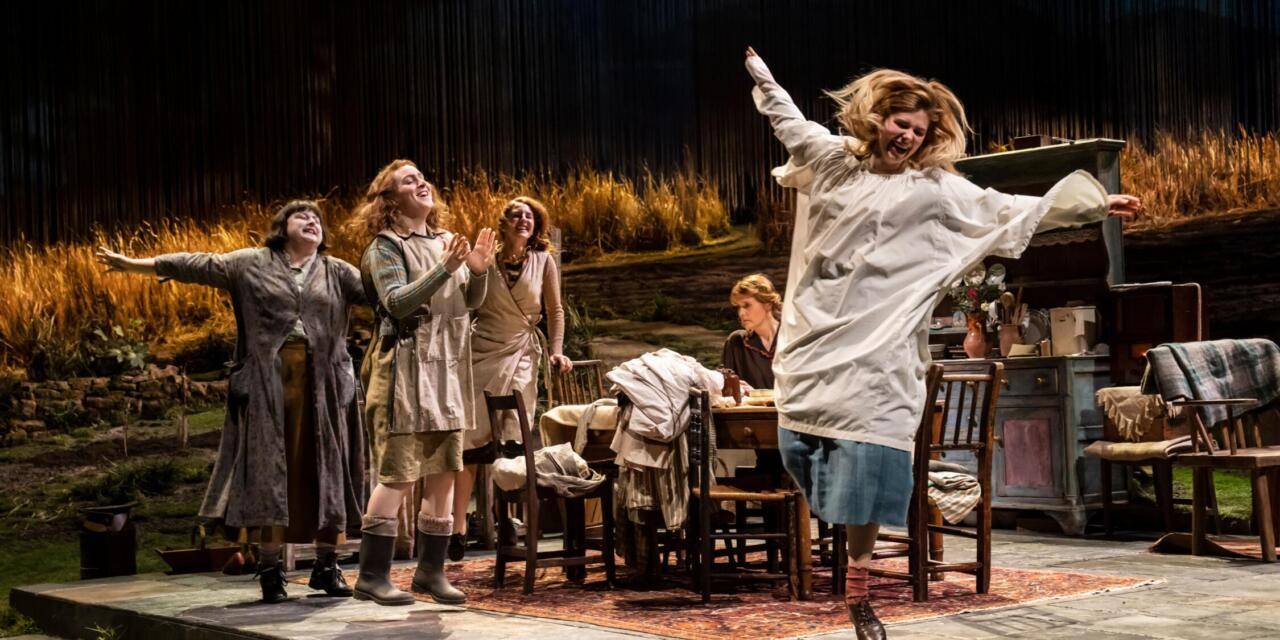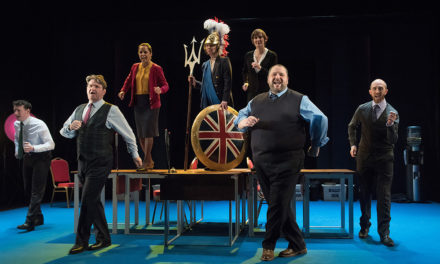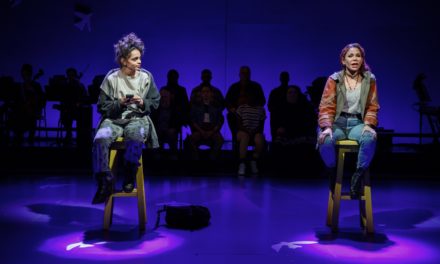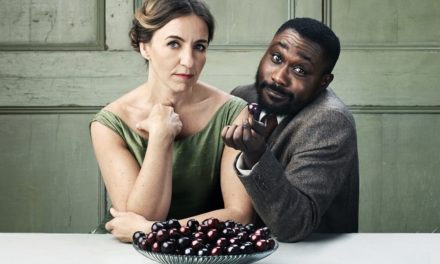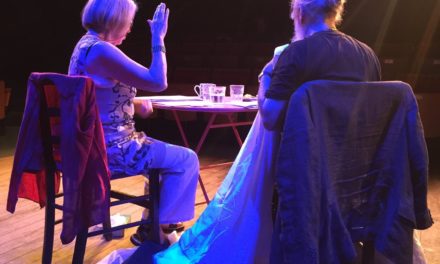The recent production of Brian Friel’s Dancing at Lughnasa at London’s National Theatre offers its English audiences what they like best: rural image of Ireland, nostalgic glow of the setting sun, unspecified sense of tragedy, recollection of better times and a whiff of atmospheric Irish music as a cultural send-off.
You should probably expect that the moment you cast your eyes on Robert Jones’s set: rural cottage kitchen with authentic utensils, yellow field of corn, winding country road, simple wooden farming machines neglected in archaic disarray. Furnishing theatrical space with this sort of props enforces the acting style and psychological model of character. The props have to be performed practically, logically and realistically, the country road just must be walked romantically, the wooden bench inescapably carries the potential for sentimental musings. Friel’s more sinister undertones, his critical edge and scepticism towards both cultural nostalgia and modernising optimism get inundated under slick realism of comic psychology and ironic references to a mainstream tv drama.
The production never allows itself for a moment of hesitation, for a pause, or suspense of belief. The five Glenties women, whose tragic fate Friel confines to a rural kitchen and a stretch of land around their cottage, spite fear and sense of failure with frantic engagement in daily chores. But Friel’s Dancing at Lughnasa is much more than a presentation of cottage realism. His play hides a rupture of the world, a calamity which cannot be stitched back even by the most arduous attempts at psychological mimicry.
Take Michael’s monologue as an example. His narrated story opens and closes the play, turning everything we see in between into a recollection of days gone by. It is therefore inevitably the narrative composed of fragments, of voluntary and involuntary memories strung together on the thread of grief, disappointment and panic. Michael’s recollections collapse under their own impossible logic, when he declares that some of the memories and emotions simply cannot be phrased in language and require music, rhythm and extra-verbal communication. With this image, Friel penetrates the areas of the emotional unknown, of the existential unheimlich. The monologue, therefore, begs for somewhat less pedantic, more loose, disconnected delivery than the one given by Tom Vaughan-Lawlor. Instead, the audience get ultra precise explanation of the play’s major events. There is therefore no real indication that the unfolding events are produced by the floating, meandering mind. Michael’s monologue is delivered with intensified rationality as if to ensure it rests in coherent psychology and sound mind. What transpires in this delivery is a sense of decorum which has to be kept to maintain the performance within the transparent real.
Dancing at Lughnasa offers an epic image of the disappearance of the known world. Traditional Ireland of 1930s vanishes under the changing economic, social, and cultural forces, and Friel’s female cast bear the brunt of this tidal evolution. They lose their jobs and means to support themselves, but also the respect of the parish priest and all chances of finding partners to start a new life. Each character collapses in their specific way, and each manifests it through a different moment of crisis. Friel is a master of personifying the mechanism of social change by loading his protagonists with the crumbling, disintegrating ethos of reality eroding into ruin. It has to be said though: the whole cast manages the psychology of this task masterfully. They all play-up their daily dialogues, routines and duties in the way that shows the characters’ effort to maintain normality against the looming disaster. With all of the actresses in the leading female roles the skill in managing realism is nothing short of stunning. The cast have a natural command for performing psychological gesture and social gestus, indicating recognisable types of emotional states, known traits of character, and peculiarities of speech. Without a doubt, there is a solid vocabulary of theatrical communication between the audience and artists. It works in a perfect conjunction of stimulation and reaction in which two sides of the dialogue know what should come next.
However, it is also difficult to escape the sense of formal stasis which permeates this production. It is as if the audience were only expected to recognise which of the known models are currently drawn on to say what there is to be said. So, each of the female roles is almost invisibly exaggerated, more coloured, more frantic than normal. This overpronounced acting idiom translates into an exaggerated profile of character. Kate (Justine Mitchell), the strict catholic, appears to be slightly too shocked in her pious exasperation to be fully credible without a portion of childish squeamishness. Maggie, played by Derry Girls star Shiobhán McSweeney, falls back on the farcical with natural spontaneity. She is clearly allowed to have a few solo moments to display her superb command of quick repartee or self-irony. In the similar vein, Ardal O’Hanlon’s Uncle Jack has been reduced to an innocently demented outcast from reality. His linguistic derangement produces situational comedy. But in Friel’s text, the figure of the uprooted, rouge priest stands for the world which has evolved beyond its own cultural origin. He shows how impossible it is to migrate between cultures, languages, geographies and communities. Characteristically, what is missing from the National Theatre production is the tragic seriousness. As if the production team were afraid of prescribing their audience a pill that has been robbed of its sugar coating.
In the National Theatre production, the two scenes which Friel uses to overturn the characters’ world seem to be played down and rendered largely ineffective. Firstly, the dance which the five sisters perform in Friel’s drama allows them to express what has been repressed in their deep individual and cultural subconscious: the need for love and eroticism, for freedom and individuality, the rejection of religious control. The NT production’s rendering of this seminal moment is a perfect illustration of energy which finally gets a moment of spontaneous display. Yet, this presentation lacks the connection with powers of a different order which in Friel’s text lie tucked behind the thin layer of reason and appropriateness and which simmer close by, in the neighbouring hills where pagan dancing starts for the Lughnasa festival. The missing element of the ritual should be there to provide a genuine force to escalate into something primal, animal, hidden, buried, and repressed which suddenly gets free into the world and poses a real threat to its existence.
Secondly, Chris and Gerry’s romantic encounters as one-time lovers who still feel so much for each other remain rather conventional and stereotypically coy. Alison Oliver as Chris and Tom Riley as Gerry act out the romantic reunion of mature lovers who behave in an innocently schoolish way. In these scenes, acting is based exclusively on stock posturing, reflecting easily recognisable models, and existing patterns. Perhaps unsurprisingly, at such moments the production clearly streamlines itself to reflect rather than disrupt the received forms and motives rooted in literary and theatrical history. Or maybe there is a different explanation for playing on the safe side here?
It seems as though the National Theatre team simply strive to achieve formal perfection. It is remarkable that Josie Rourke’s production ends with exactly the same silent tableau with which it begins: Uncle Jack seated on the wooden bench, others geometrically planted among various pieces of the setting. Why? Why return to the static, opening scene? The world of the characters has disintegrated, leaving their lives with no hope or future. The concept of the production clearly works against the more provocative and controversial senses of the original text. To deepen the soothing effect of the final tableau, the audience are sent home to the calm melody of traditional Irish music gently oozing from the outer space of the auditorium. So peaceful. We feel so satisfied, empowered, gentrified and unreflective.
This post was written by the author in their personal capacity.The opinions expressed in this article are the author’s own and do not reflect the view of The Theatre Times, their staff or collaborators.
This post was written by Michał Lachman.
The views expressed here belong to the author and do not necessarily reflect our views and opinions.

